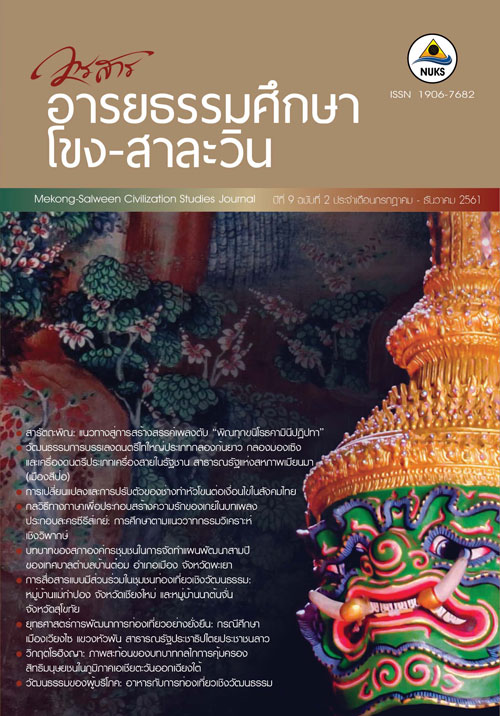Tai Yai’s Musical Performing Culture of Glong Gon Yao, Glong Mong Seong and Stringed Musical Instruments in Shan State, the Republic of the Union of Myanmar (Hsipaw City) วัฒนธรรมการบรรเลงดนตรีไทยใหญ่ประเภทกลองก้นยาว กลองมองเซิง และเครื่องดนตรีประเภทเครื่องสายในรัฐชาน สาธารณรัญแห่งสหภาพเมียมา (เมืองสีป่อ)
Main Article Content
Abstract
This research aims to study physical, sound characteristics, performance methods performing techniques and melodies of Klong Kon Yao, Klong Mon Soeng drums and the string instruments of Thai Yai in Hsipaw City, Shan state. Klong Mong Soeng were not found. Klong Kon Yao performance usually begins with Mong (small gongs), followed by Klong Kon Yao and Chab Yai (large cymbals). The various melodies reflect their functions. The first style played in the auspicious ritual procession consisted of drumming of ‘poeng’ sounds beaten with open hands in syncopation with Mong. The second style, found in the Fon Nok Dance, uses mostly the loud ‘poeng’ sounds interspersed with few ‘poob’ sounds produced by close-hand beating. The third style accompanies the Fon Toh Dance with diminished melodies. The last style accompanies Kaa Pan Klong Dance with short, rapid strumming and diminished melodies. Klong Mong Soeng were not found.
Tor Yor Horn has five techniques: precise pitch rendering, repeated pressing, sliding, 16th /32th - note embellishment, trilling with triplets. All seven notes are used with syncopation and synchronization covering three notes above an octave. It accompanies a song, an interlude and in an ensemble setting. The embellishments of vocal melodies are more common than musical accompaniments. Two extra measures at the end of the tunes emphasizing the final pitch and “Tad Hua Tam Tai” technique, in which no stress is placed at the beginning of the singing while an extra melody is added to its ending, are common.
Downloads
Article Details
References
Jangyod, S. Interviewed on March 14, 2014.
Jangyod, S. Interviewed on March 15, 2014.
Mulmek, A. (2005). Shan State History and Revolution. Bangkok: Matichon Press.
Poolsuwan, S. (2017). Shan State (Tai) Bangkok: Princess Maha Chakri Sirindhorn Anthropology Center.
Sao Yawd Serk, Peng Keaw, N. and Burapawat, N. (2012). The Horizon Shan. Bangkok: Siam Parithas Press.
Sangjing. Interviewed on March 13, 2014.
Sangtorn. Interviewed on March 11, 2014.
Sang-A. Interviewed on July 17, 2014.

